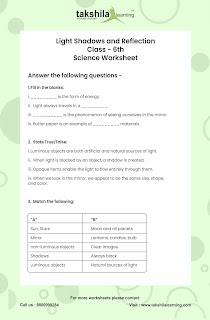Worksheet for Class 6 Science - Light and Shadow
1. Complete the following sentences:
1. Fill in the blanks:
- The type of energy is._______
- Light always follows a ________ path.
- The phenomena of seeing ourselves in the mirror is known as ._______
- ________ materials include things like butter paper.
2. Give True/False answers:
- Luminous objects can be artificial or natural light sources.
- A shadow is generated when light is blocked by an object.
- Items that are opaque allow light to pass completely through them.
- We appear to be the same size, shape, and colour when we glance in the mirror.
3. Match the following:
“A” “B”
Sun, Stars Moon and all planets
Mirror Lanterns, candles, bulb
non-luminous objects Clear images
Shadows Always black
Luminous objects Natural sources of light
4. What are the characteristics of images?
5. Discuss Transparent, opaque, and translucent objects.
Click for the answer of the Light Shadows and Reflection Class 6 worksheet

Comments
Post a Comment
Thank you we will contact ASAP.